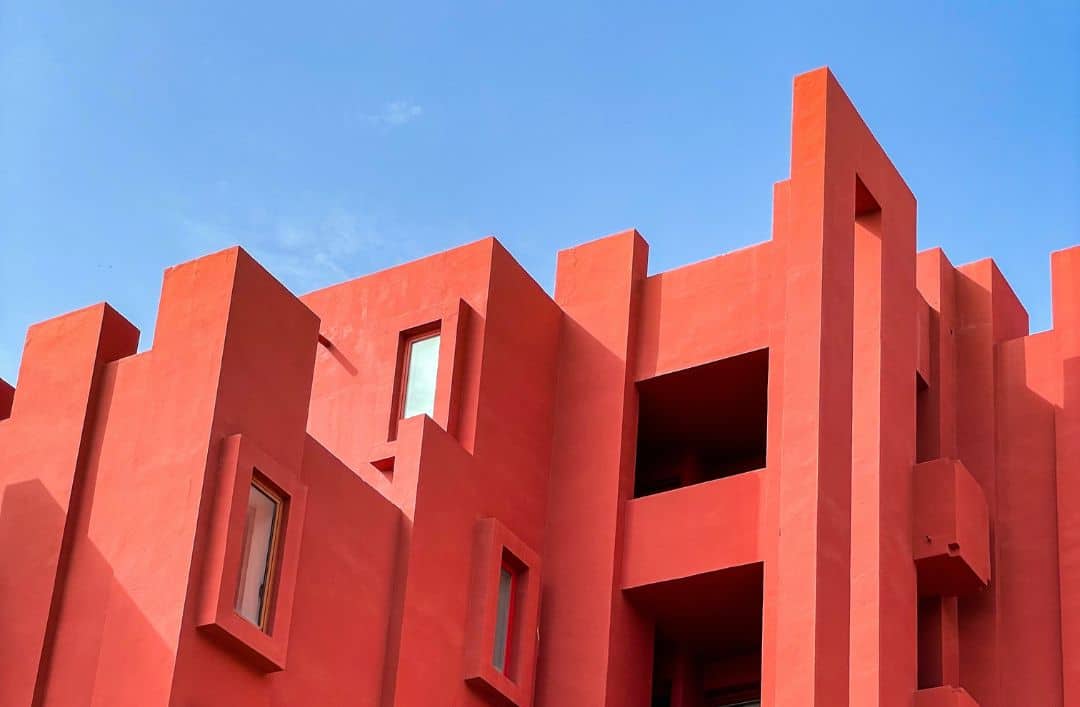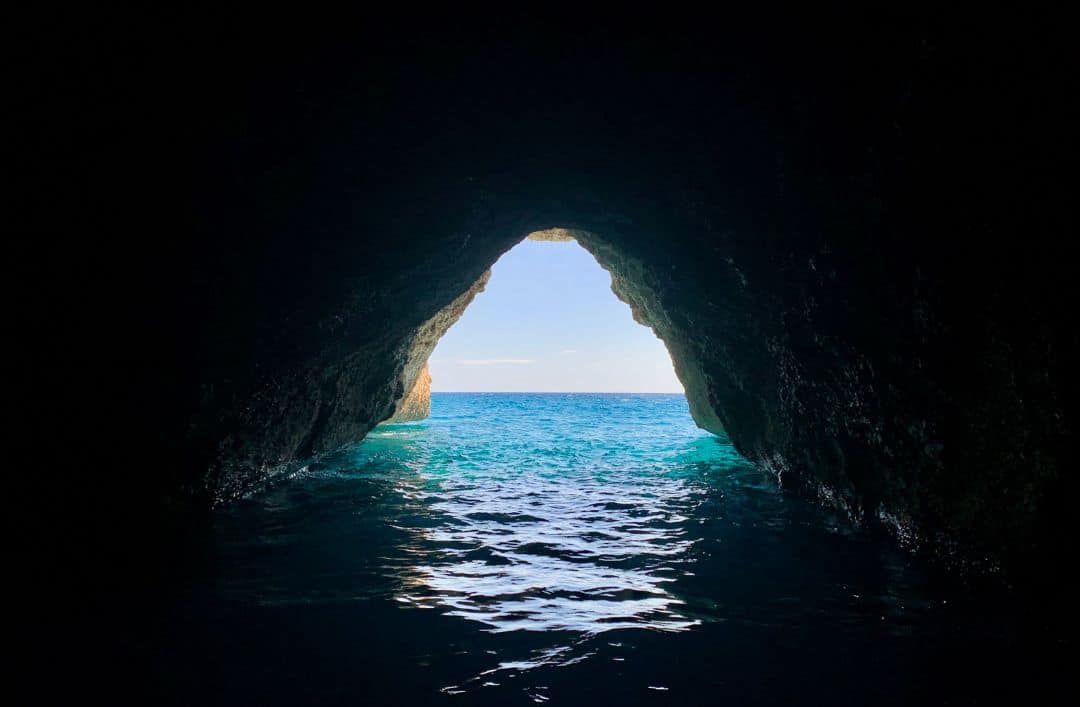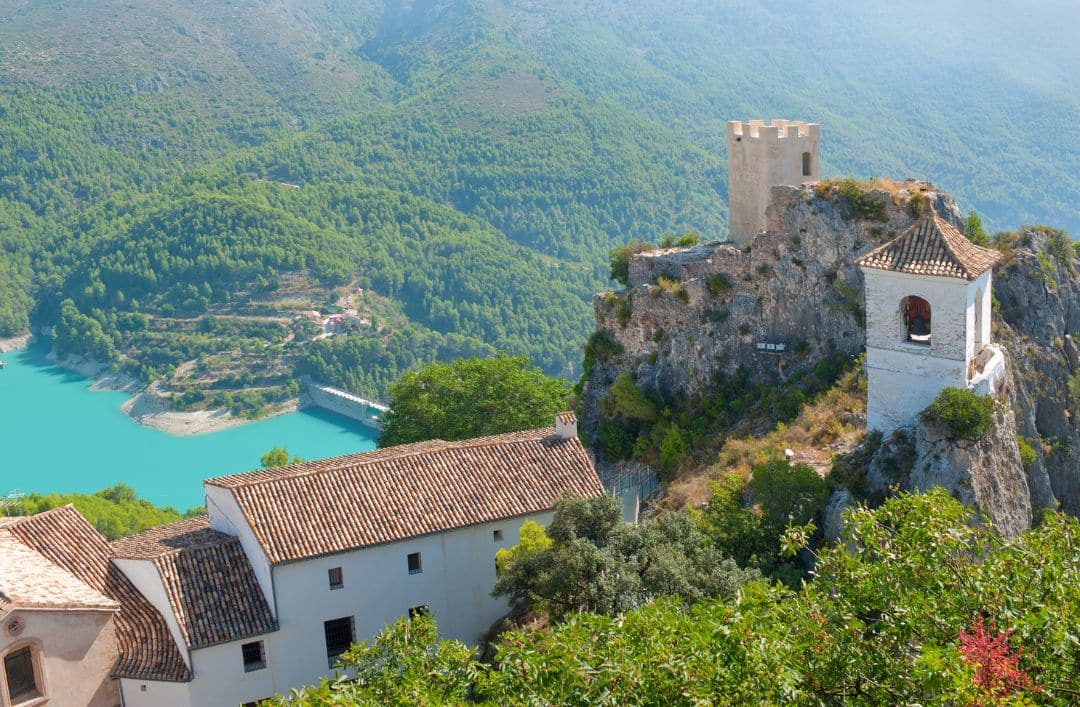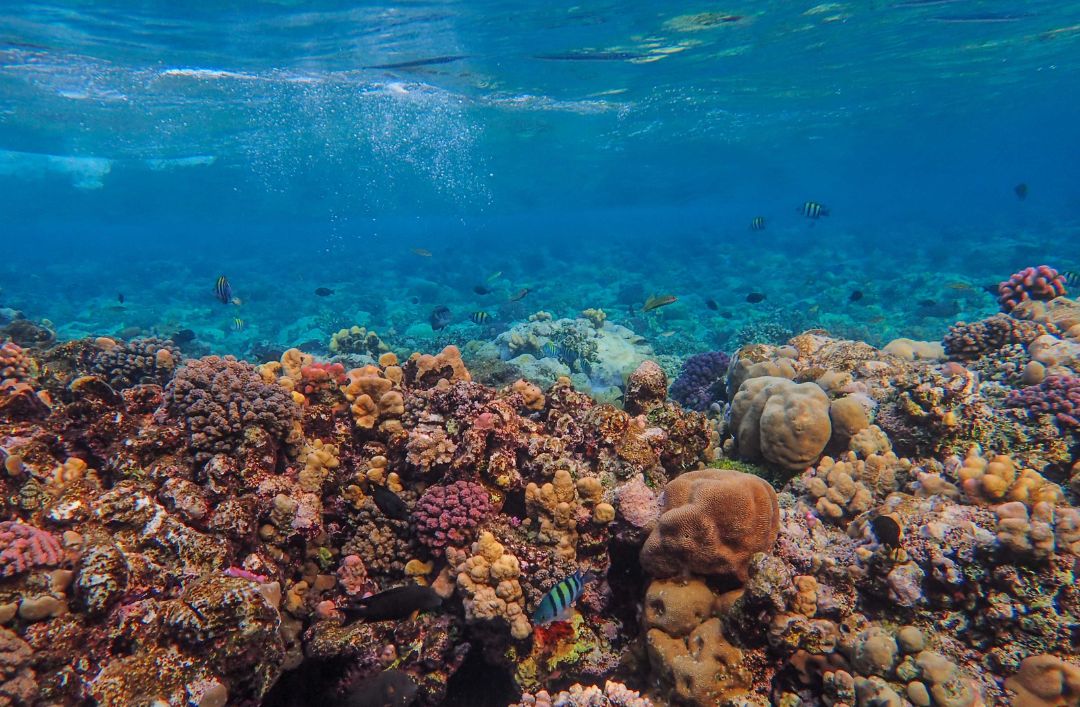
Apr 4, 2023 | Activities/Services, Cumbre del Sol, Other towns
The Costa Blanca Norte is a paradise on earth. Not just because of its incredible climate but also for its many different landscapes and scenarios. Grab your mobile phone or camera, make sure you have plenty of battery, and get ready to take some stunning photos!
The Red Wall in Calpe
If you are a fan of Instagram you will be well aware that the above photo pictures the Muralla Roja or Red Wall. This construction is located in the Manzanera development and was designed and built by Ricardo Bofill. Moreover, this just happens to be the 50th anniversary of its construction. It was inspired by African adobe towers and it is striking for its characteristic range of colours and its straight lines. The building has been declared a cultural heritage site. The stairs actually inspired those that feature in the famous Squid Game series. And given its rather peculiar beauty it has been used as the scenario for numerous commercial videos for brands such as Zara. It is certainly one of the coolest places on the Costa Blanca Norte!
Cala Barraca in Jávea
This rocky cove is also known as Portitxol as it looks out onto the island of that name, which is some 300 metres across. You can get to the island by canoe or Jet Ski. You could also swim there but be careful if it is windy. This little beach is also striking for its white fishermen’s huts and the well-known blue door. One interesting activity in this area is scuba diving. And other sports include canoeing. Make the most of the dawn light for a truly memorable photo!
Forat de Bernia in Benissa
If you have ever been looking for photos of the beaches in Costa Blanca Norte, you will certainly have come across a picture of this place. It is actually an aperture in the rocks that affords a fantastic view of the bay of Altea. To get there first you must walk along a little hiking trail. It is an easy enough, however as the path can be a bit stony it is best to wear appropriate footwear. It is also gets quite busy along the trail so if you want a photo without lots of people, make sure you set out early.
Altea old town centre
Altea is a charming little town ideal for taking a stroll with your camera. The narrow streets of the old town are a well-known scenario. In fact, the place is often referred to as the “Balcony of the Mediterranean”. It has several iconic spots such as the Glorieta del Maño lookout point. Although if you are looking for something a little bit different, just go for a wander around. However, be ready to climb a few steep hills… The old town centre of Altea is so lovely that a snapshot of just about anywhere here would be worth uploading to your Instagram feed.
Cala Granadella in Jávea
The Cala de la Granadella is close by Cumbre del Sol. This little cove is famous for the blue colour of its waters that ranges from turquoise to emerald green. It is such a lovely beach that it tends to be very popular with visitors. To protect the place, sometimes daily visitor numbers are restricted. As a result we suggest you visit this beach out of season. Make the most of the proximity of your home to take some fantastic photos! It is the perfect scenario for snapshots of nature or water sports such as snorkelling.
The summit of Peñón de Ifach in Calpe
This peak or Peñón as it is known locally is one of the most iconic spots on the Mediterranean coast. And especially appreciated in the Costa Blanca Norte. The limestone peak rises to 332 metres. It has been declared a Nature Reserve and as it receives so many visitors, it is necessary to apply for permission to visit. The reason is that visits are restricted to a daily quota of 300 people. Therefore, if you are thinking about taking some photos for your social networks, bear that in mind. It is a truly iconic place with enormous charm. You won’t want to leave without taking a great photo!

Mar 6, 2023 | Activities/Services, Cumbre del Sol
When some weeks ago we told you about the most interesting caves that you can visit inland in Costa Blanca Norte, we decided it would be a good idea to follow up with a second part to tell you about the sea caves in the area. Most of these are in the vicinity of Cumbre del Sol and it’s possible that there may be some that you don’t know about yet.
Cova del Riu Blanc
Close by the Cala del Moraig beach and Cova dels Arcs, in Benitachell, the Cova del Riu Blanc is concealed inside La Falla del Moraig. It can be accessed from the sea by swimming from Cala Moraig, a distance of some 250 to 300 metres (although we advise swimming with flippers, paddle surfing or canoeing). The falla del Moraig is a spectacular, almost vertical wall of rock. Its polished appearance and the striations caused by friction of the blocks clearly show the geological movements that led to this rock formation. The fault seems to be suspended in the air over a lake and in its interior lies the underwater entrance to Riu Blanc. However, be especially careful when entering the cave, as it can be extremely dangerous to linger there when the tide is rising. To ensure a safe visit, it would probably be best to contact one of the local companies that organise trips and that way you make sure that your visit will be safe and secure.
Cova dels Arcs
The Cova dels Arcs, which is also in Benitachell, as well as being a magical place for watching the sun rise or for snorkelling (in the well-known “divers’ chamber”, the easiest to access), is also an ideal area for expert cavers who can enter what is considered to be the longest underwater outlet to the sea in Spain.
Jávea: cave zone
Next we go to the Jávea district to discover the Cova Tallada. In this spectacular cave, remains have been found from the Al Andalus era of Spain and there you can picture how this quarry was in use from the 12th century, and there are legends that tell how it was once a marine refuge during the Second World War. Technically, it is not a completely natural rock formation as it has been altered by man through repeated removal of the roughhewn rock. The area outside the cave is perfect for snorkelling and especially worth seeing is the 16th century inscription that reads: “PHILIPUS III HISP REX CAVERNAM HANC PENETRAVIT AN MDXCIX” (Philiip III visited this cave in 1599).

We consider that the ideal access to the Cova del Llop Marí is by sea, however, this will always depend on conditions such as the wind, waves and currents. This is one of the best kept secret places of the Costa Blanca Norte, with its amazing crystal clear waters and nooks and crannies filled with marine life.
Continuing in Jávea, we come to the Cova dels Òrguens. This is a particularly special place at the foot of Cap de la Nau, and it’s possible to enter by small boat, surfboard or canoe.
Denia: Cova De L’Aigua
One of the most historic caves, frequently used in the past, is Cova De L’Aigua which is a refuge for marine flora, and in the past it also served as a shelter for Roman soldiers. In fact, it is still possible to see an inscription in this regard engraved on the cave wall (protected by a grill). Rainwater has filtered into the interior of the cave and it was used as a water tank until the 16th century.
Every secret corner of the Costa Blanca Norte comes as a surprise. We have mentioned some of the sea caves that are hidden away under the finest waters in the Mediterranean. We suggest you follow our upcoming blog posts to keep abreast of everything going on in Residential Resort Cumbre del Sol.

Feb 20, 2023 | Uncategorized
It is a given that the Costa Blanca has a wealth of beaches and sandy coves with their crystal clear waters and EU blue flags, and it is something that we are all aware of. However, in addition, and just a short distance away from those beaches, you can find the most charming villages in the Mediterranean as well. And now it isn’t just us telling everyone this, because recently, the National Geographic magazine published its list of 100 most beautiful villages in Spain, which means that a visit is definitely on the cards for 2023, and two of these are very close to Residential Resort Cumbre del Sol.
Altea: The Pearl of the Costa Blanca
“With the sun’s first rays, Altea wakes to the screeching of gulls as they faithfully hover over the seagoing craft moored in the port, along with others that, on the distant horizon, are a reminder that this Alicante village was once peopled by fishermen and labourers”; so begins the description of Altea in the article. It comes as no surprise that the “dome of the Mediterranean” makes the list too, but that doesn’t make it any less a matter of great pride. There are myriad reasons for its inclusion, with its narrow streets and whitewashed houses that lie cheek by jowl with the blue dome of its church, it manages to create a pure Mediterranean landscape that makes you want to explore each and every little nook and cranny of the place. From the highest and most ancient part of the village you will be treated to unique views of the two sides of the Costa Blanca Norte, namely, the mountain sierras of Aitana, Bernia and the Puigcampana on one hand, and Punta Albir, the Morro de Toix and the Peñón de Ifach circling the bay, on the other.
In addition, a visit to the Monastery Church of the Carmelitas Descalzas, La Torre de la Galera, which have been declared a Cultural Heritage site, La Torre Bellaguarda, the Palau de Altea and a stroll along the seafront, will provide images and snapshots that will stay in your memory forever.
In the entry on Altea it also mentions the well-known neighbourhood of El Fornet “with its narrow cobbled streets and its white houses festooned with a colourful jumble of geraniums, jasmine and bougainvillea”.
Guadalest, an unmissable mountain trip
Just the mere fact of its history should earn it a well-deserved mention in lists of this kind: Guadalest was moulded both by the hand of man and the force of nature following the earthquakes of 1644 and 1748, when the citadel castle of San José was virtually destroyed. Today it still stands proud and open to the sky with several sections of the wall remaining along with its keep which is still easily recognisable.

Strolling through the small historic centre, which is reached through the only door in the ancient walls, is like stepping into another world. The town hall square with its statue of San Gregorio and the medieval prison provides a meeting point for visitors. Special mention should be given to the Casa de los Orduña, from where you can access the top of the castle. The village is crowned by the famous castle of the Alcozaiba, which recalls the medieval origins of the village, and from here you can view the mountain sierras of Xortà and Serrella, along with the mountains of Aitana and Bernia.
In the outskirts, you will find the reservoir, wetlands and the dam of Guadalest. This is one of the most picturesque places in inland Costa Blanca, and not to be missed if you visit the village. The water from this reservoir comes from the river Guadalest which, with its blue waters, frames this lovely village. The reservoir, as well as contributing to the charm and beauty of Guadalest, also boasts a really easy and pleasant hiking trail that circles the whole reservoir so you can see the fantastic countryside up close as you breathe in the fresh mountain air.
Altea and Guadalest are as different from each other as they are special. Each one has its own charm and special features that make the villages unique, and it is not the first time that National Geographic mentions them. In its 2022 list, it included the village as one of the five most beautiful villages of Alicante province. Don’t forget to check out our upcoming blog posts where we will tell you more about some of the most special places in the Costa Blanca and the surrounding area.

Feb 9, 2023 | Activities/Services, Benitachell, Cumbre del Sol, Other towns, Otros pueblos
It might not be the best known attraction of the Costa Blanca Norte, but the interior of many of the region’s mountains harbour a network of caves (some of which are open to visitors while others remain inaccessible) that enrich the landscape, and when you venture inside some of them you may well come across vestiges of the past life of this place.
The latest exciting news about the world of caves concerns Cova de les Morretes in Benitachell. Following some important 20th century finds involving treasure, work on restoring the cave has now been completed and if you are walking the Ruta dels Penya-Segats trail, you will come across it in an exclusive location that boasts some of the finest views of the Costa Blanca Norte. A museum no less, that looks out to sea.
These caves once served as a refuge for locals who struggled to make a living from fishing and by working the adjacent terraces. In order to supplement their meagre income, they also dabbled in a bit of smuggling, most likely tobacco.
Having completely restored the walls, roof and some of the interior elements, while at all times keeping the essence of the place and its original materials, the idea of this Cultural Heritage site is to “museumise” the cave so that it can be visited both physically and virtually, making it accessible to anyone interested in paying a visit. So now you have something more interesting to do on your Sunday hiking trail near Cumbre del Sol!
Costa Blanca Norte: cave area
If a visit to the Cova de les Morretes has whetted your appetite, you’re in luck. As we mentioned, the Costa Blanca Norte harbours a multitude of caves to visit or view on your country walk. We tell you about some of them below.

Rull Cave
This cave is in Vall de Ebo. It was discovered by José Vicente Mengual, known as Tío Rull, in 1919. In the 60s it was restored and made available for visits, and remained open to tourism until 1970. Later it was inherited by his heirs who sold it to the Public Authority in in 1995 and it was again opened to tourists, once the installations had been refurbished. Today it is open to the public and you can also take advantage of a guided visit as well.
Las Calaveras Cave
This cave which was discovered in the 16th century is in Benidoleig and is 70 metres above sea level. Its takes its name from the fossilised remains of hyenas, horses, bears, bulls hippopotamus and rhinoceros that were found in the cave interior, which are now housed in Alcoy museum.
Adsubia Cave
Also known as the cave of Canalobres (not to be confused with the Caves of Canelobre) you will find this cave in Adsubia. It is a perfect example of a little corner of the subterranean world that conceals a wealth of valuable natural treasures that are guaranteed to make your visit an amazing experience.
Canelobre Caves
These caves are found in Busot and they are probably the best known of this whole list. They consist of a space extending over more than 80,000 m², accessed through a 45 metre tunnel, in which water and rock have combined over centuries to create impressive stalactites, stalagmites and columns. One interesting fact in this regard is that the roof of the cave is one of the highest vaults in the whole of Spain, measuring 70 metres high. Not only that, due to its magnificent acoustics, it has been used on numerous occasions for music concerts.
As always, the Costa Blanca Norte can surprise you when you are least expecting it. In this blog post we have told you about the caves that can be found in the mountain areas, however, in an upcoming post we plan to tell you all about the wealth of marine caves that lie under the Mediterranean waters. Keep an eye open for our future blog posts!

Jan 30, 2023 | Activities/Services, Other towns
Water comprises almost three quarters of the Earth. Water flows through different places, rivers, lakes, glaciers, seas, and oceans. Most of it in these last two bodies of water, and of those, we only know about 5% of their depths which harbour treasures in the deep just waiting to be discovered.
The Costa Blanca Norte is an unmissable destination for fans of scuba diving. The main reason is the beauty of the marine depths that are host to an enormous wealth of flora and fauna which will delight anyone seeking to explore the sea bed. Throughout this area you will find different routes for diving and there are several schools where you learn about this sport, such as La Galera or Dive & Dive. In this blog post we tell you about some really special ones.
Starting out at La Granadella
For real beginners, or those without much experience who want to get involved in this world, our first recommendation would be to follow one of the underwater routes that you can find at La Granadella beach. It is well known for the beauty of its sea bed and admired by all divers. In fact, the route closest to the beach, from where it can be accessed directly, is an easy one with a maximum depth of around 10 metres.
El Vaporet
A few miles from the port of Denia, you can find “El Vaporet”, a former cargo vessel that sank in the late 19th century. If you dive there you will see several species that shelter in the wreck, as there are no rock formations in the vicinity, and you can find conger eel, lobster, spiny lobster, along with white seabream, gilt head bream and grouper. They are, however, found at a considerable depth, and given the currents there, and possibly reduced visibility, it is advisable to undertake this particular route only when conditions are excellent, and if you are a really experienced diver.
El Freskito
You´ll find this place on the beach of las Rotas de Denia, some 4 km from the port. In the swimming pool created by natural rock and transparent sea water, this easy and beautiful route begins. It’s a good idea to explore the craggy rocks that make up the pool walls as there you may see octopus, European fan worm, spoon worm and perhaps a Moray eel.
Cap de Sant Antoni: La Cullerà and Primera Ensenada
The first of these caves can be found at the foot of the cliffs of the Marine Reserve of Cap de Sant Antoni. If you want to dive in this cave, which penetrates up to 50 metres into the mountain, it is necessary to get permission from the Board of the Environment to explore it. Armed with this permit, you can explore the cave which is at a depth of 9 metres where you will find slipper lobster, meagre, and a conger eel here and there. Not to mention octopus, sea bream, grouper and plenty of meagre hiding in the myriad nooks and crannies in the rocks.

Another excellent route in this area is Primera Ensenada, which is just before you reach the lighthouse. This area is protected (you will need authorisation to enter) and lies at a depth of 16 metres where the sea bed is shaped by the large rocks scattered here and there in the sand, and it offers an exceptionally beautiful and lively environment, perfect for seeking out species that are difficult to spot in other places.
The area around the Cap de Sant Antoni lighthouse is also a place where you can contemplate the beauty of the Costa Blanca marine depths. Here the enormous rocks on the seabed are particularly striking, as they create passageways and a play of shadow and light, providing a spectacle that will charm underwater photographers. Throughout the route you will see the white gorgonian coral, and depending on how close to the rock wall you venture, you can dive down from 12 to 19 metres, a depth at which you can spot an even greater variety of interesting species of flora and fauna.
Doesn’t it make you want to get into your wetsuit? Whether you live close to Cumbre del Sol or you simply came upon this artícle when you were looking for things to do on the Costa Blanca Norte, we would encourage you to enter this marvellous world and discover the best waters that the Mediterranean sea has to offer.









